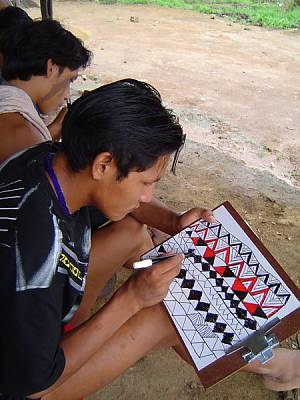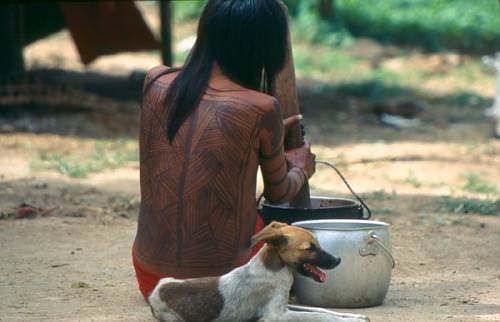Oral and graphic expressions of the Wajapi
Inscribed in 2008 (3.COM) on the Representative List of the Intangible Cultural Heritage of Humanity (originally proclaimed in 2003)
Country(ies): Brazil
Identification
Description

- Oral and graphic expressions of the Wajapi
- © Dominique Tilkin Gallois
The Wajapi of the Tupi-guarani cultural-linguistic group are indigenous to the northern Amazonian region. Some 580 Wajapi live in 40 small villages on a specially designated territory in the state of Amapá. The Wajapi have a long history of using vegetable dyes to adorn their bodies and objects with geometric motifs. Over the centuries, they have developed a unique communication system – a rich blend of graphic and verbal components – that reflects their world-view and enables them to hand down knowledge about community life.
This graphic art is known as kusiwa and its designs are applied with red vegetable dyes extracted from the roucou plant mixed with scented resins. The Wajapi consider that the technical and artistic proficiency required to master the drawing technique and the preparation of the dye cannot be attained before the age of forty. Commonly recurring motifs include the jaguar, anaconda, butterfly and fish. Kusiwa designs refer to the creation of humankind and come alive through a rich corpus of myths. This body art, closely linked to Amerindian oral traditions, possesses multiple meanings on socio-cultural, aesthetic, religious and metaphysical levels. Indeed, kusiwa constitutes the very framework of Wajapi society and is endowed with significance extending far beyond its role as a graphic art form. This coded repertory of traditional knowledge is perpetually evolving as indigenous artists are constantly reconfiguring the motifs and inventing new patterns.
Although the Wajapi live on their protected territory, their traditional lifestyle, including the practice of kusiwa, is in danger of losing its symbolic significance and may even disappear altogether. Such a loss would drastically alter the community’s social and cosmological reference points. The principal threats stem from disinterest on the part of the younger generation and the decreasing number of Wajapi proficient in the kusiwa repertory.
Slideshow
Video
These videos (and many more) can also be consulted through the UNESCO Archives Multimedia website
Safeguarding project (07-2006/11-2008)
Wajapi communities in northern Amazonia have a long history of producing and using vegetable dyes to adorn their bodies with geometric motifs and symbols. Motifs of the jaguar, anaconda, butterfly and fish animate the worldview and oral traditions of the Wajapi.
The safeguarding project aims at supporting the Wajãpi in their efforts to document their skills, experiences and knowledge related to their manifold oral and graphic expressions as they are embodied, most prominently, in the kusiwa graphic system. This project will complement the broader set of activities undertaken by the “Wajãpi Programme”, which started in 1992.
The project focuses on documentation and dissemination of information related to the oral and graphic expressions of the Wajãpi. The participative documentation will be undertaken by the Wajãpi themselves. The project is composed of three main lines of action: (i) undertaking of an ethnological survey, (ii) elaboration of an inventory in the form of an electronic database in close cooperation with the respective custodians, (iii) implementation of dissemination and diffusion activities on Wajãpi oral and graphic expressions” focus on both young Wajãpi and public managers working with indigenous communities in order to increase their knowledge and appreciation of Wajãpi oral and graphic expressions and the need to safeguard the context in which they are practiced.












